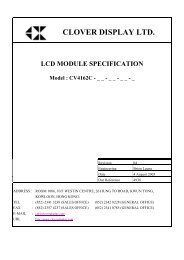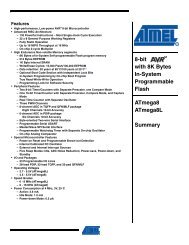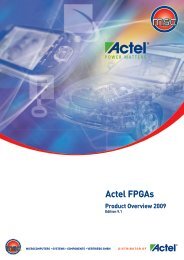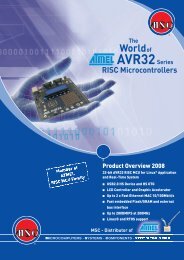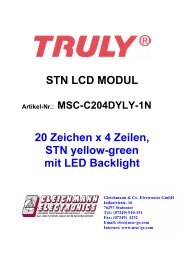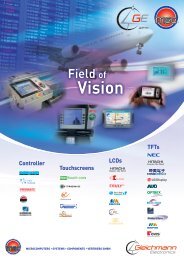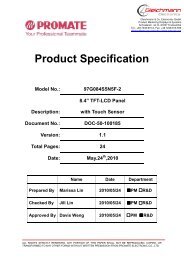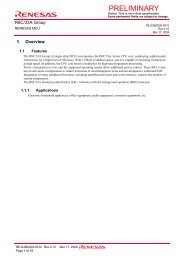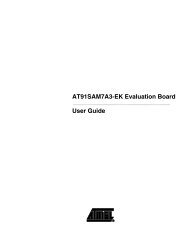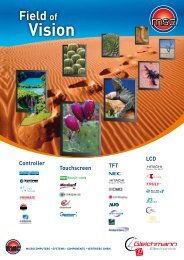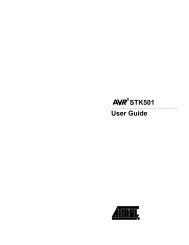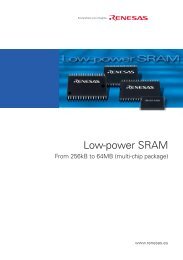SL811HS Embedded USB Host/Slave Controller
SL811HS Embedded USB Host/Slave Controller
SL811HS Embedded USB Host/Slave Controller
Create successful ePaper yourself
Turn your PDF publications into a flip-book with our unique Google optimized e-Paper software.
<strong>SL811HS</strong><br />
<strong>SL811HS</strong> <strong>Slave</strong> Mode Registers<br />
Table 19. <strong>SL811HS</strong> <strong>Slave</strong>/Peripheral Mode Register Summary<br />
Register Name<br />
Endpoint specific register addresses<br />
EP 0 – A EP 0 - B EP 1 – A EP 1 - B EP 2 - A EP 2 - B EP 3 - A EP 3 - B<br />
EP Control Register 00h 08h 10h 18h 20h 28h 30h 0x38<br />
EP Base Address Register 01h 09h 11h 19h 21h 29h 31h 0x39<br />
EP Base Length Register 02h 0Ah 12h 1Ah 22h 2Ah 0x32 0x3A<br />
EP Packet Status Register 03h 0Bh 13h 1Bh 23h 2Bh 0x33 0x3B<br />
EP Transfer Count Register 04h 0Ch 14h 1Ch 24h 2Ch 0x34 0x3C<br />
Register Name<br />
Miscellaneous register addresses<br />
Control Register 1 05h Interrupt Status Register 0Dh<br />
Interrupt Enable Register 06h Current Data Set Register 0Eh<br />
<strong>USB</strong> Address Register 07h Control Register 2 0Fh<br />
SOF Low Register (read only) 15h Reserved 1Dh1Fh<br />
SOF High Register (read only) 16h Reserved 25h-27h<br />
Reserved 17h Reserved 2Dh-2Fh<br />
DMA Total Count Low Register 35h<br />
DMA Total Count High Register 36h<br />
Reserved<br />
37h<br />
Memory Buffer<br />
40h – FFh<br />
When in slave mode, the registers in the <strong>SL811HS</strong> are divided<br />
into two major groups. The first group contains Endpoint registers<br />
that manage <strong>USB</strong> control transactions and data flow.<br />
The second group contains the <strong>USB</strong> Registers that provide the<br />
control and status information for all other operations.<br />
Endpoint Registers<br />
Communication and data flow on <strong>USB</strong> is implemented using<br />
endpoints. These uniquely identifiable entities are the<br />
terminals of communication flow between a <strong>USB</strong> host and<br />
<strong>USB</strong> devices. Each <strong>USB</strong> device is composed of a collection of<br />
independently operating endpoints. Each endpoint has a<br />
unique identifier, which is the Endpoint Number. For more<br />
information, see <strong>USB</strong> Specification 1.1 section 5.3.1.<br />
The <strong>SL811HS</strong> supports four endpoints numbered 0–3.<br />
Endpoint 0 is the default pipe and is used to initialize and<br />
generically manipulate the device to configure the logical<br />
device as the Default Control Pipe. It also provides access to<br />
the device's configuration information, allows <strong>USB</strong> status and<br />
control access, and supports control transfers.<br />
Endpoints 1–3 support Bulk, Isochronous, and Interrupt<br />
transfers. Endpoint 3 is supported by DMA. Each endpoint has<br />
two sets of registers—the 'A' set and the 'B' set. This allows<br />
overlapped operation where one set of parameters is set up<br />
and the other is transferring. Upon completion of a transfer to<br />
an endpoint, the ‘next data set’ bit indicates whether set 'A' or<br />
set 'B' is used next. The ‘armed’ bit of the next data set<br />
indicates whether the <strong>SL811HS</strong> is ready for the next transfer<br />
without interruption.<br />
Endpoints 0–3 Register Addresses<br />
Each endpoint set has a group of five registers that are<br />
mapped within the <strong>SL811HS</strong> memory. The register sets have<br />
address assignments as shown in the following table.<br />
Table 20. Endpoints 0–3 Register Addresses<br />
Endpoint Register Set<br />
Address (in Hex)<br />
Endpoint 0 – a 00 - 04<br />
Endpoint 0 – b<br />
08 - 0C<br />
Endpoint 1 – a 10 - 14<br />
Endpoint 1 – b<br />
18 - 1C<br />
Endpoint 2 – a 20 - 24<br />
Endpoint 2 – b<br />
28 - 2C<br />
Endpoint 3 – a 30 - 34<br />
Endpoint 3 – b<br />
38 - 3C<br />
For each endpoint set (starting at address Index = 0), the<br />
registers are mapped as shown in the following table.<br />
Table 21. Register Address Map<br />
Endpoint Register Sets<br />
(for Endpoint n starting at register position Index=0)<br />
Index<br />
Endpoint n Control<br />
Index + 1<br />
Endpoint n Base Address<br />
Index + 2<br />
Endpoint n Base Length<br />
Index + 3<br />
Endpoint n Packet Status<br />
Index + 4<br />
Endpoint n Transfer Count<br />
Document 38-08008 Rev. *D Page 12 of 32<br />
[+] Feedback



